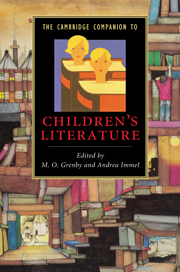Book contents
- Frontmatter
- Part I Contexts and Genres
- 1 The origins of children’s literature
- 2 Children’s books and constructions of childhood
- 3 The making of children’s books
- 4 Picture-book worlds and ways of seeing
- 5 The fear of poetry
- 6 Retelling stories across time and cultures
- 7 Classics and canons
- Part II Audiences
- Part III Forms and Themes
- Further reading
- Index
5 - The fear of poetry
from Part I - Contexts and Genres
Published online by Cambridge University Press: 28 November 2010
- Frontmatter
- Part I Contexts and Genres
- 1 The origins of children’s literature
- 2 Children’s books and constructions of childhood
- 3 The making of children’s books
- 4 Picture-book worlds and ways of seeing
- 5 The fear of poetry
- 6 Retelling stories across time and cultures
- 7 Classics and canons
- Part II Audiences
- Part III Forms and Themes
- Further reading
- Index
Summary
Critics in children's literature studies, by and large, tend to ignore children's poetry, but one can hardly blame them. Exciting and innovative work appears fairly often in fiction, many picture books offer enticing visual and literary pleasures, and there are several non-fiction works for young people that are sophisticated and illuminating. But, with some notable exceptions, the vast bulk of children's poetry published today is goofy, sentimental or recycled from days of yore. As I write, the most recent children's poetry bestseller list from the Poetry Foundation (a spin-off of Poetry magazine in Chicago) contains, besides work by Shel Silverstein and Jack Prelutsky, primarily anthologies, such as Mary Engelbreit's Mother Goose: One Hundred Best-Loved Verses (2005) and A Family of Poems: My Favorite Poetry for Children (2005) edited by Caroline Kennedy. Caroline is, like her mother, a celebrity anthologist, and Mary Engelbreit is a franchise. This is, for the most part, the kind of fare one encounters at the large chain bookstores like Barnes and Noble.
This market-driven narrowing of the genre is a shame because children's poetry is historically an expansive body of work. Until recently, the distinction between poetry for children and poetry for adults has been usefully blurred: prior to the late twentieth century, poetry anthologies for children tended to include verse traditionally considered 'adult', as well as an eclectic mixture of light verse, nonsense verse, narrative verse, along with lyric poetry.
- Type
- Chapter
- Information
- The Cambridge Companion to Children's Literature , pp. 76 - 90Publisher: Cambridge University PressPrint publication year: 2009
- 5
- Cited by

